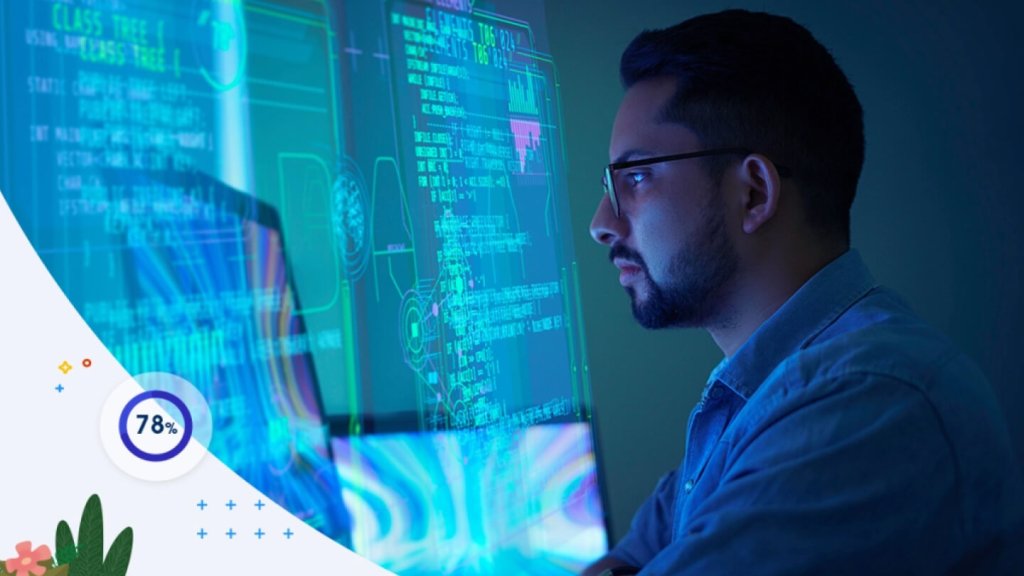



Generative AI is already helping companies build stronger customer relationships and changing the way business works.
Whether you’re just starting out with AI or you’re already innovating around the technology, this guide will help you strategize effectively, embrace new possibilities, and answer important questions about the benefits of AI.
The information in this playbook comes from Salesforce experts in AI, data, and CRM. We’re committed to providing our employees, customers, and partners with the tools they need to develop and use this technology safely, ethically, and accurately.

Salesforce Artificial Intelligence
Salesforce AI delivers trusted, extensible AI grounded in the fabric of our Einstein 1 Platform. Utilize our AI in your customer data to create customizable, predictive, and generative AI experiences to fit all your business needs safely. Bring conversational AI to any workflow, user, department, and industry with Einstein.
Chapter 1 Plan your approach.
The age of generative AI is upon us.
AI is growing faster than any technology of our time.
It’s tempting to dive right in. But let’s take a pause.
As business leaders, we all want to fully take advantage of the capabilities of AI to create efficiency and drive business growth. But we also have an important responsibility to ensure that AI is safe, inclusive, and trustworthy.


AI Built for Business
Enterprise AI built directly into your CRM. Maximize productivity across your entire organization by bringing business AI to every app, user, and workflow. Empower users to deliver more impactful customer experiences in sales, service, commerce, and more with personalized AI assistance.
A thoughtful approach starts with trust.
Generative AI is capable of creating text, music, images, and even computer code, and can drive incredible customer experiences and business benefits. But right now, there’s an AI trust gap. For CEOs, AI is the #1 priority, but 73% of employees believe that generative AI introduces new risks. Privacy, hallucinations, data control, bias, and toxicity are just some of their concerns.
Like meaningful relationships between brands and customers, AI’s success must be based on trust. You need to promote confidence and lessen potential ethical and security risks as you use generative AI to open the door to richer customer experiences.
Create guidelines for ethical use.
You will only earn your users’ trust if you can demonstrate that outcomes and decisions made by generative AI models are effective, accurate, and free of bias and toxicity. It’s important to put ethical guardrails and guidance in place to help you innovate responsibly, stay ahead of potential issues, and create safe, trustworthy practices for your business.
Putting the right guardrails around generative AI is critical. Recent surveys found that:
Here are five guidelines![opens in a new window]() your company can use to inform how your team works and steer the development of trusted generative AI.
your company can use to inform how your team works and steer the development of trusted generative AI.
- Accuracy
Train your AI models with trusted data to deliver verifiable results. Be sure to communicate openly about where there is uncertainty or the answer isn’t clear. - Safety
Regularly conduct bias and explainability assessments to help mitigate potential harms. Protect personally identifiable information (PII) data when used for training. - Transparency
Be sure to have consent for data usage by relying on open-sourced and user-provided datasets, and use ethical sources. Always be transparent when delivering AI-generated outputs. - Empowerment
AI is best used as an assistant. Ensure there is human input built into the process to reduce potential harms or inaccuracy. Ensure outputs are accessible and treat content creators with respect. - Sustainability
Strive to rightsize the models by prioritizing high-quality, representative training data. This will reduce the energy required for computation and lessen the carbon footprint.
Set trust standards to keep your data safe.
While you want to take advantage of the productivity gains enabled by third-party generative AI models, these models handle your data in new ways. Data is typically stored in databases, documents, or files, for which access can be specified by location. But the large language models used for generative AI don’t store data, they learn it. In a learned environment, you can’t put the same types of access controls that you’ve used in the past, as the data you put into a prompt is also learned by the model and becomes part of the output.
These six trust standards prevent business showstoppers and provide clear guardrails you can bring to any team, vendor, or partner.
- Secure data retrieval and dynamic grounding
Ensure the data retrieved for a generative prompt upholds permission levels and users only see information and outputs they have authorization to access.
“Ground” your model in the context of specific use cases to ensure the quality and accuracy of a generative output. This means creating prompts that inject information from factual, validated sources like knowledge articles from your own database. - Data masking
By masking personally identifying information (PII) that is shared in a prompt, you can use data sets to create better outputs without exposing the real data to outside sources or models. - Prompt defense
Protect against hackers and harmful outputs by using prompt defense guardrails. This includes prompt instructions such as “Do not address any content or generate answers you do not have data or basis on,” or, “If you experience an error or are unsure of the validity of your response, say you don’t know.” - Toxicity detection
Run the outputs from third-party models through a separate large language model optimized for detecting harmful content—that is, content that is abusive, hateful, or violent in nature — so it can be flagged before ever being used. - Zero data retention
Establish security controls and zero data retention policy agreements with external AI models to ensure both your prompts and outputs are erased and never stored. - Auditing
Make sure you have an audit trail so your teams can inspect code and sourcing to continue to refine your model and maintain compliance with current and emerging legal and ethical standards.
See trusted generative AI in action
Checklist for building trust in generative AI:
- Define and align on ethical principles and guidelines
.
- Update your security and purchasing guidelines to include trust standards like data masking and zero retention to ensure your data remains safe.
- Establish a diverse team of experts to lead risk reviews and use tools to detect bias
.
- Provide companywide education
to spot bias and reduce risk.
- Build trust by showing customers you understand pain points
and growth potential, implementing effective data governance, and offering transparency into your model’s inputs, outputs, and potential biases.
Chapter 2: Ready your technology.
Define AI use cases with your customer at the center.
AI has the potential to reshape every corner of your company, from sales to service, from marketing to commerce. You can anticipate customer behavior, understand customer satisfaction, and create more personalized experiences.
When integrated right into the flow of work, predictive and generative AI can help you make informed decisions based on business insights, and create content in natural language. It can make an immediate impact in almost every department.
An audit of current operations across departments will help you identify tasks and processes that can benefit from predictive and generative AI optimization. By pinpointing areas where AI can provide actionable insights, improve decision-making, enhance customer experiences, or reduce costs, you can align the technology with strategic business goals and drive customer value. And you can refine models continually, improve performance, and make more informed decisions.
Explore some of the most common use cases by department.
When you train generative AI with your data and CRM, you can improve customer experiences and decision-making, while driving productivity and efficiency. See how.
Help sales close deals faster.
- Prioritize opportunities
- Identify best next step actions
- Generate personalized communications
Streamline customer service.
- Generate relevant answers
- Handle inquiries with chatbots and virtual assistants
- Drive efficiency and cost-effectiveness
Personalize marketing offers.
- Identify target audiences
- Optimize campaign offers
- Create more resonant content
Increase commerce conversion rates.
- Personalize recommendations
- Enhance post-purchase operations
- Improve fraud detection
Help IT teams deploy faster.
- Provide performance and operational insights
- Make data-driven decisions
- Leverage AI-generated code
Focus your team on high-value tasks.
As you explore the next steps in your AI transformation, it’s important to involve your teams, many of whom have growing concerns about the future of their jobs.
But AI can help remove the drudgery from day-to-day work and free up time for employees to be more creative and focus on impactful areas of your business. Augmenting complex tasks and automating time-consuming manual work with generative AI gives people the opportunity to work smarter.
Use this exercise to identify the best opportunities for automation and augmentation with your teams.
Ready your data environment.
Every AI project should begin as a data project. And that data? It can’t live in silos. If it does, you risk lower quality outputs from your gen AI.
The first important step is to connect, organize, and harmonize your data so you can understand and meet the needs of your customers with generative AI.
Connect your customer data.
Ask these questions to determine how you bring together data from different sources.
Hosting: Where is your data currently hosted? Is it in multiple clouds or multiple orgs?
Data residency: What type of data residency does your organization need to support — that is, what countries and regulatory requirements must be considered?
Data structure: Is the data structured, such as product inventories or sales opportunities, or is it unstructured, such as PDF files and chat transcripts?
Real time vs. batch processing: What data sources need to update and stream in real time?
- Transactional data: Information that captures customer and business transactions such as dates, time, place, and names. This data requires updates over time and includes examples like opportunity records, order status, and customer service cases.
- Engagement data: Data that records a moment in time such as visits to a webpage, interactions with a device, or economic and environmental data. This data is important to have in real time, so you can create fresh interactions and personalization.
A data platform lets you integrate large amounts of data from any source, standardize formats, and ensure consistency and integrity. You can’t expect all of your data to live in one place, so you’ll need to create sharing mechanisms, such as data lakes or warehouses, to allow different departments to access and use the data. Proper governance needs to be incorporated, including access controls, data privacy, and security measures for protecting sensitive information.
Map to your customer data model(s) and perform customer identity resolution.
Once your data is connected, the next step is to organize and harmonize your data in relation to your customer data model. It’s essential to have a customer relationship management (CRM) system to get a complete, 360-degree view of your customer data.
If your teams are not already together on CRM, you won’t have the full picture you need to get useful results from your models.
You can harmonize data in your CRM by using AI to create a set of match rules for customer identity resolution.
When you bring data together from across your company and incorporate generative AI, your CRM becomes a centralized hub for creating unified customer profiles that all your teams can access.
Checklist for readying your technology:
- Define and align on companywide data metrics
, principles for providing customer value, and use cases for incorporating AI.
- Connect your data environment to improve real-time decision-making and customer experiences with customer profiles and one unified source of truth.
- Find ways to provide more customer value through personalization.
- Find ways to increase productivity with automation
and augmentation.
- Empower teams to integrate AI into their processes and products through clear guidelines.
Chapter 3 Enable your people.
Build an AI-ready workforce.
With technology changing fast, your training practices need to keep up. While about two-thirds of employees use or plan to use generative AI at work, nearly 61% of those who plan to incorporate the technology don’t know how to use trusted data sources or keep sensitive data secure.
"Removing fear and helping everyone understand what is and isn’t possible will lead to more valuable use cases, with the business and technical stakeholders working in partnership to drive innovation."
Dr. Andy Moore, Chief Data Officer, Bentley Motors
Here are seven skill sets for employees to sharpen as you incorporate AI into the flow of work:
- Adaptability and continual learning
Openness to change, adaptability, and a commitment to career-long learning are foundational if employees want to stay up to the minute with AI advancements. - Data literacy
Invest in growing data literacyby encouraging skills in data collection, preparation, exploration, visualization, and understanding data ethics and privacy. Then, prioritize data in decision-making and business processes and align to business outcomes.
- Domain knowledge
Understanding the challenges and pain points of an industry or domain where AI will be applied, such as healthcare, finance, marketing, or manufacturing. - Communication and collaboration
Ensure leaders have strong communication skills to convey how your AI tech will work across teams, with shared organizational goals. - Prompt writing
Learn how to write prompts to ensure quality AI output. - Problem-solving and analytical thinking
Gen AI pairs best with critical thinking, experimentation, iteration, and effective problem-solving skills. - Technical skills
Gain proficiency in programming (Python, R, etc.), data analysis, statistics, machine learning, deep learning, and natural language processing (NLP).
Our free online learning platform, Trailhead, offers easy-to-consume modules or “trails” to help your team acquire the skills they’ll need to get started with generative AI. You’ll also find trails for data analytics and machine learning, with new topics added all the time.
You can also stay on top of all the latest AI developments with our “Ask More of AI” newsletter.
Checklist for readying your people:
- Determine which skills your workforce needs and set priorities.
- Make time and space for employees to receive training.
- Offer your workforce continuous training to gain new skills as generative AI technology evolves.
- Check out Trailhead
, the fun, free online learning platform from Salesforce.




